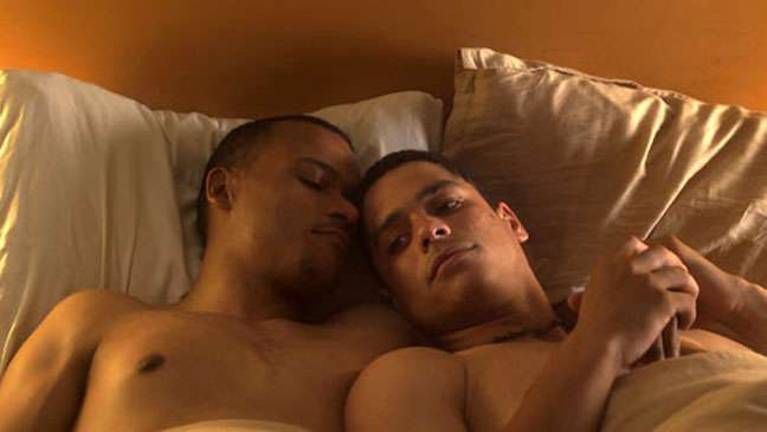The GPS Dance

Urban romance takes a spin in The Happy Sad
When Pet Shop Boys released Very (their finest album?) 20 years ago, its AIDS-era sensibility was a landmark in pop sexual identity. Probably too subtle for mainstream recognition, its sophistication can yet be universally appreciated. The territory explored on Very's opening track ("Can You Forgive Her?") is evoked by the sexual competitiveness of the millennial characters--a heterosexual and gay couple--in The Happy Sad.
These young adults hurt each other because they can't decide which side of the road they want to sleep on. The fact that they have options doesn't mean they live on carefree terrain without sink-holes and pitfalls. Director Rodney Evans uses an emotional Global Positioning System in this adaptation of Ken Urban's original stage play--emphasis on urban as when Marcus (Leroy McClain) complains to Aaron (Charlie Barnett), "You read my e-mail, then you go screw some NYU boy!" The Happy Sad depicts the particularly urban opportunities for hook-ups and confusion now available to young men and women who use the city to sort out their sexual and sentimental affinities. Not simply another gay love story like Weekend, the recently overrated British film, The Happy Sad crosses Marcus and Aaron with Annie (Sorel Carradine) and Stan (Cameron Scoggins); the two couples collide through bisexuality as another complicated option.
What the Pets knew about the range of fluid sexual identity in contemporary London's bars, theaters and the romantic imagination of its socialites is repeated in Evans' understanding of young New Yorkers' sexual traffic. Evans showed a similar awareness in his 2004 debut Brother to Brother (a rare film about gay life in Harlem, partly a biography of the poet Bruce Nugent). In The Happy Sad, Evans observes the world of struggling artists, waiters and indie rock where the classes and races also converge and combust. The very daring Annie proposes a new-style relationship to Stan: "We can be different. Try something new. Open things up." He's willing but she's more honest: "It's like you're my boyfriend and my gay best friend rolled up into one."
Interestingly, the film doesn't pivot around Stan; even though he is the common link to the characters he's no less confused than the others. But as the white male, privileged by cultural hegemony, Stan represents something distinctive in Evans' worldview. All the actors are attractive but Stan's singer-songwriter ambitions (and coy swagger?) position him as the sexual ideal all the characters must pass through--even the black male couple Marcus and Aaron who confuse that normative ideal with love. In the film's most subtle development, Annie eventually steers herself away from that ideal toward two ethnically and emotionally different women.
In the urban dance that is The Happy Sad, deep emotions appear on the surface but seem superficial. We've seen this dance in greater art like Max Ophuls' La Ronde with its elegant juxtaposition of erotic fears and delusions. This is a La Ronde for the post-AIDS era, infected by inconstancy and impatience. ("We've got unlimited minutes, now listen!" Marcus demands.) Esthetically, Evans doesn't achieve Ophuls' visualization of spatial/spiritual distance as when Marcus and Aaron phone each other from adjacent rooms. He could study Antonioni, too.
Still, no Mumblecore film that I've seen explores personal relations with this kind of acuity--and no Woody Allen movie, either. The value of Evans and Urban's contribution to New York cinema comes out of their informed attention to urban mixing: how women and men traverse the security of race and genre roles, sorting out a sense of being that Pet Shop Boys might approve.
Follow Armond White on Twitter at 3xchair